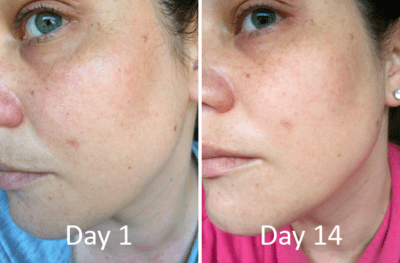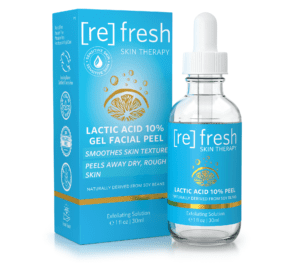How do you know which chemical skin peel is right for you? Glycolic Acid and Lactic Acid are both are proven to be effective and safe for a wide array of skin concerns, unlike many of the latest “miracle” skincare ingredients on the market (snail slime cream, anyone?).
So what’s the difference between the two? When deciding whether lactic acid vs glycolic acid is right for you, a lot depends on your skin sensitivity, oiliness, and problems you’re attempting to correct.
Below are some helpful tips to help you decide:
If You Want to Lighten Dark Spots
Lactic Acid and Glycolic Acid both work well to fade excess pigment in skin, and will slowly fade dark spots and even out skin tone if you have patchy skin, scars, freckles, sun spots, or melasma.
Lactic Acid is generally less irritating, so if you sunburn easily, or have been known to breakout with new perfumes or soaps, Lactic acid should be your first choice. If your skin is not particularly sensitive, you could use either Glycolic or Lactic (or both) and see what works for you. For best results, use a daily Vitamin C Serum for more lightening power and sunscreen to prevent sun damage.
Note: Dark Spots and scars are deeper in the skin than acne or fine lines, and take the longest to see improvement. You should aim to use whichever peeling agent as often as allowed according to the instructions, and it can take 6-8 weeks to see real improvement.
If You Have Keratosis Pilaris (KP)
Keratosis Pilaris, those little ‘chicken skin’ rough patches usually found on the back of arms and legs, are very common (around 50% of the population has it), and can be so annoying when it’s time to wear short sleeves! Your best bet here would be a Lactic Acid based product to dissolve the little keratin plugs which are causing the bumps.
The good news is that you should feel softer skin after one treatment, with continued improvement and potentially even full clearing with regular use. Unfortunately, you can’t be ‘cured’ of Keratosis Pilaris, so if you stop the routine, the bumps come back. The key is finding a simple routine that you can stick to. For best results, we recommend a regular peel with Lactic Acid 10% Gel Peel (once a week), along with daily scrubbing with a loofah, followed by a Lactic Acid cream (like AmLactin) to give you baby soft skin!
If You Have Acne or Acne Scars
If you’ve ever suffered from acne, then you know sometimes it can take more than one product or ingredient to get totally clear skin. That is because there are often multiple causes for acne. You might have a few clogged pores, but then also get hormonal breakouts around your period, or acne rosacea on your cheeks.
Glycolic Acid and Salicylic Acid, when used in combination, are a very effective preventative treatment for acne. Glycolic acid clears away dead skin cells, so they don’t hang around to clog pores and cause a breakout. Studies also show Glycolic acid prevents skin from over-producing oil, and helps to fade old acne marks and scars. Salicylic acid works to reduce redness and inflammation, and kill acne bacteria.
To fight acne, we recommend: a daily treatment with our Salicylic Acid 2% Daily Peel, and with a once or twice a week use of a stronger Glycolic Acid-based peel treatment.
If You Have Dry Skin
Have you ever finished putting on lotion or makeup, to only see flakes of dry skin everywhere? Cold dry climates (and going from dry cold air outside to super-heated dry air inside) can do a number on skin, and make it hard to stay hydrated. Piling creams on top of creams still might not be enough, especially if not done in the right way.
First, you need to exfoliate the outer layers, so your moisturizer can get to the living skin cells, to help the hold onto precious moisture. Your best bet in this case would be using a Lactic Acid peel, 1-2 times per week. Lactic acid is less irritating and drying then Glycolic Acid, and actually helps skin retain moisture better. The follow with a water-based moisturizer, and then finally a few drops of oil on top, to seal the moisture to your skin, so it doesn’t evaporate.
If You’re Starting to Notice Fine Lines / Wrinkles
Either of these will be a good choice to improve the appearance of fine lines and wrinkles. That is because both Glycolic and Lactic Acid stimulate skin’s natural production of collagen, the substance which gives your skin it’s natural bounce. Regular use should “plump up” fine lines and wrinkles from the inside, which will look more natural and is less invasive than using botox or other injectibles.
So if you have sensitive skin, Lactic Acid is probably your best bet, but if not, you either is a good choice – or use both!
Lastly, a summary to help you decide which is the best option for your skin:
Lactic Acid Peels
- A less-irritating AHA (alpha-hydroxy acid)
- Good for sensitive skin types since it’s less likely to burn/tingle
- Excellent skin lightening treatment, when followed with a Vitamin C treatment.
- Good for dry skin and Keratosis Pilaris
Glycolic Acid Peels
- Very effective exfoliator, bore likely to cause slight skin irritation such as redness and slight burning/tingling sensation.
- Improves the look of fine lines and wrinkles by boosting your skin’s natural collagen production
- Good for fading dark spots, skin lightening / brightening
- Clears pores to prevent acne breakouts and fade old acne scars
And don’t just take our word for it, here are what our actual customers are saying:
Lactic Acid 10% Gel Peel
“I have been using another [re]fresh product (2% willow bark) for several months and decided to try this 10% lactic acid peel. I was happy with the willow bark but this item is a bit more assertive. My face does get rosy for several hours, but that goes away. I am very pleased with how my skin feels after I wash it. It looks and feels smoother, plus my laugh lines are definitely lessened. That is a good thing!” —-Brooklyn Granny
“Great product. I do a peel once a month and my skin looks great. I use other products also, but I like the feel of this. My dermatologist says I have great skin for being 59.” —-Montana Gal
Fruit Acid 15% (Lactic and Glycolic) Gel Peel
“I grew up with acne. I’m 31 now but have embarrassing scars I cover up with makeup everyday. My face has never gone without makeup. I have no money so never went to get professional peels. I took a chance and bought this. After 2 weeks acne scars are 50 percent diminished. I am peeling during the day but anyone with my issue realizes that it’s worth it. My self esteem is rising and am thankful for this product.” —Amazon Customer
“I had one of those never-ending pimples on my left cheek that started to form in mid-August. It took several weeks for it to get to the point where it was an actual post- inflammatory hyperpigmentation mark, and not an active pimple disguising itself as PIH. It’s been over three months since I’ve been battling this bugger in some form or fashion; and the PIH is seemingly just as stubborn as the pimple that caused it.
I used the [re]fresh 15% Fruit Acid Peel four times in two weeks: twice on its own and twice layered on top of my other regular peels (mandelic and lactic, both 40%). I wasn’t expecting the [re]fresh fruit acid to be a miracle product for this one spot because of its strength, but I was absolutely curious to try it and I’m really glad I did.
Although the super-human PIH didn’t fade much over the two weeks, I definitely saw noticeable improvement in the fine lines under my eyes. They are smoother and my overall skin is softer. I also saw a decrease in the redness around my nose and inner cheeks.
Conclusion: I would recommend this product to anyone who is new to chemical peels or who wants to add a slight boost to their existing peel’s effectiveness. I love that it doesn’t contain alcohol — an ingredient found in most chemical peels that can wreak havoc on my dry skin.” — Meg



P. Mack
What’s a sicken?…Do you mean skin?
Jo
Yes, I think the customer’s first language is not english and it’s a translation mistake, but I knew what she meant.
bertha
this is my fest time of buying this product, i jest want to lightening my sicken, i need help how to uesed the product properly thanks.i have a dry sicken